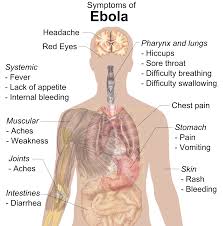
Ebola outbreak in the present year 2014 is considered to be the largest outbreak of Ebola as per the World Health Organization (WHO) which has declared it an international emergency. Ebola virus has already gripped West African nations and till now, Ebola outbreak has recorded a fatality rate of about 80% which is quite a high number. Keeping in view the ever shrinking globe, Ebola virus can shock anybody in any country with its presence. The only key to save oneself and dear ones from Ebola virus infection is creating awareness and taking steps to prevent it. Here is all about Ebola virus- what are the causes of Ebola infection, its symptoms, diagnosis, treatment and prevention- the facts about Ebola virus to help you keep distance from this very dangerous infection.
What is Ebola Virus Disease?
Ebola virus disease which was previously known as Ebola hemorrhagic fever, is a fatal illness having a death rate of up to 90% and is caused by Ebola virus. Ebola can be defined as a group of viruses causing hemorrhagic fever as it leads to bleeding inside as well as outside infected body. To be precise, Ebola virus causes an infectious and fatal disease which shows itself as fever and severe internal bleeding. This disease spreads through contact with infected body fluids of Ebola virus. Having quite a long incubation period (8 to 21 days), Ebola viral infection can gradually lead to organ failure and, in many cases, death. There is still no cure for Ebola virus infection.
About Ebola Virus
Ebola is one of the most deadly viruses having a fatality rate between 50 to 90%. Ebola virus is native to Africa where occasional outbreaks have occurred for decades. This virus lives in animal hosts and has been found in African monkeys, chimps and other nonhuman primates. Human beings can come in contact with this virus through infected animals. Once Ebola virus contracts a human being, it can then spread from one person to another and so on, primarily through contact with body fluids or contaminated needles. Till now, no medicine has been identified that can treat Ebola virus. If someone is diagnosed with Ebola, supportive care and treatment for complications are given by the doctors.
Symptoms of Ebola Virus Infection
The early symptoms of Ebola virus infection are tough to detect as that resemble the symptoms of many other common diseases like flu, infections, typhoid, cholera etc. The incubation period of the Ebola virus also varies from person to person. It can be anywhere between 2-21 days. Incubation period is the time between the exposure to the virus to the time when a person feels and sees the symptoms. Even after this incubation period, the patient can only see the early symptoms like fever, headache, body pains and aches, weakness etc. Over time, the symptoms of Ebola worsens and may include vomiting, diarrhea, rashes, stomach pain, bleeding etc. Here is the list of early symptoms as well as severe symptoms that show off after some time.
Early Symptoms of Ebola Infection
- Fever
- Headache, sometimes severe headache
- Joint and muscle pain
- Chills
- Weakness
- Sore throat
- Lack of appetite
Severe Symptoms of Ebola Infection
- Nausea and vomiting
- Diarrhea, even bloody diarrhea
- Red eyes
- Rashes, which can be raised rashes too
- Chest pain
- Cough (patients may cough up blood too)
- Stomach pain
- Weight loss
- Bleeding from eyes
- Bruising (patients who are severely affected by Ebola virus and are near death may bleed from ears, nose and rectum)
- Internal bleeding
Causes of Ebola Virus Infection
It is now clear that Ebola disease is caused by virus from the Filoviridae family, commonly known as Ebola virus. It is actually transmitted from animals to humans and then it spreads from person to person by direct contact with the bodily fluids of such an infected person or animal. According to scientists, there are five different types of the virus that can infect humans. World Health Organization (WHO) says that Ebola disease can be caused by close contact with the blood, secretions, organs or other bodily fluids of infected animals. In humans, Ebola disease can be caused by the following methods.
- Contact with blood, secretions, organs or other bodily fluids (stool, urine, saliva, semen) of a person who is infected with Ebola virus.
- Contact with the meat of an infected animal. Even handling such meat can cause Ebola infection.
- Contact with the bodily fluids of a person who has passed away due to Ebola disease.
- Contact of broken skin or mucous membranes of a healthy person with contaminated things like soiled clothing, bed linen, or used needles.
- Doctors and other healthcare workers may be infected by Ebola disease through transmission or by coming in contact with infected bodily fluids.
Transmission of Ebola Virus
While it may be clear now that the Ebola virus is first transmitted from animals to humans and then from an infected human being to other humans. However, if you want to know how this transmission actually takes place, here are the facts about transmission of Ebola virus from animals and from humans.
Transmission of Ebola Virus from Animals to Humans
Some of the examples about how the Ebola virus gets transmitted to humans from an infected animal include the following.
- It can be transmitted through the blood of the infected animal like when someone butchers or eats such an infected animal.
- Scientists who research upon and doctors who operate such infected animals may also contract the virus.
- Coming in contact with the feces or urine of infected animals can also cause transmission of the virus.
Transmission of Ebola Virus from Human to Human
It should be made clear here that until a person develops the symptoms of Ebola infection, he or she does not become contagious and can not cause Ebola disease in others. It is only when a person starts showing symptoms that he becomes a carrier of Ebola virus.
- Family members who take care of sick relatives infected with Ebola virus may catch the disease.
- People who touch the infected dead body, such as during preparation for last rites, may also get the virus.
- Doctors and healthcare professionals who do not use protective surgical masks and gloves etc. may get infected with the virus.
- Reusing of needles and syringes that are used for an infected patient transmits the virus to another person. Non sterilized injection equipment can dangerously spread the Ebola virus.
Diagnosis of Ebola Virus Disease
Symptoms alone cannot be used to diagnose Ebola virus disease as these may resemble the symptoms of other diseases such as cholera or malaria. Generally, some tests of blood and tissues are done to diagnose Ebola. These test may include the following.
- Enzyme-linked immunosorbent assay (ELISA)
- Reverse transcriptase polymerase chain reaction (PCR)
- Complete blood count (CBC)
- Blood coagulation test (to measure blood’s ability to clot and how long it takes)
- Viral antigen testing (to check for the presence of viral antigen)
- Liver function test
There may be some other tests too that a doctor may deem fit to diagnose whether a person suffers from Ebola infection. If a person is diagnosed with Ebola, he is immediately isolated from the public so that the disease can be prevented from spreading.
Treatment for Ebola Virus Disease
Till now, no antiviral medicine or drug has been proved to be effective against Ebola virus infection. Patients who need treatment are given supportive care and medicines for relief from symptoms. Severely ill patients are given intensive supportive care along with intravenous fluids or oral rehydration with solutions containing electrolytes. Some patients do recover with appropriate medical care. Supportive hospital care includes the following.
- Providing fluids for rehydration
- Maintaining blood pressure
- Providing oxygen when and as required
- Replacement of lost blood
- Treatment for other infections that may develop
In some advanced countries like USA, an experimental serum that destroys infected cells are also given to the patients. Generally, the aim of Ebola treatment is to treat the symptoms and to prevent secondary infections as well as complications such as pneumonia and liver failure.
Prognosis of Ebola Disease
According to the World Health Organization’s reports, as many as 80% of the people infected with Ebola virus die. However, the high rate of death is generally because of a drop in their blood pressure and failure of organs rather than from blood loss.
When to Seek Medical Care for Ebola Disease?
The only way to survive from Ebola disease is to seek prompt medical care as soon as one comes in contact of the virus or at least when symptoms are seen. Seek medical help in the following situations.
- If you travel to a place where it is known to have Ebola virus disease such as in African countries.
- If you come in contact with a person having Ebola viral infection.
- If you come in contact with a person suspected to have Ebola disease.
- If you have symptoms of or similar to Ebola virus disease, immediately seek medical care.
Ebola Virus Prevention
At present, there is no medicine or vaccine for Ebola virus disease though many researches are on to develop vaccines as well as medicines for Ebola virus disease. Current policy for prevention of Ebola disease focuses on avoiding contact with the virus. The precautions that can help prevent Ebola infection are listed below.
- Avoid traveling to areas of known Ebola outbreaks. Africa is one such place. If the travel to such place can’t be avoided, find out about the current epidemic outbreaks.
- Maintain basic hygiene. Wash your hands frequently and properly. Use soap and water to wash hands frequently. When soap and water are not available, use alcohol-based hand rubs that contain at least 60% alcohol.
- Drink clean water from a clean source.
- Cook meat thoroughly and properly. Never eat undercooked meat.
- Avoid having bush meat (the meat of African wild animals as food).
- When you are in some developing countries, avoid contact with wild animals. Don’t buy them or eat them including nonhuman primates that are sold in local markets.
- Avoid contact with Ebola infected people.
- If you are a caregiver for an infected person, avoid contact with patient’s body fluids and tissues which includes blood, semen, vaginal secretions and saliva.
- Know that the Ebola patients are most contagious when at later stages. Take utmost care to not to come in contact with any of their body fluids.
- Health care worker should wear protective clothing like gloves, masks, gowns and eye shields.
- Always keep infected people away from others.
- Dispose of the used needles properly and sterilize other instruments.
- Do not try to prepare for last rites of people who died due to Ebola. Let the specially organized and trained teams to handle burials and other procedures regarding death rituals. They should use appropriate safety equipment while doing so.
- If you notice any symptom that resemble those of Ebola, seek medical care.
Ebola Virus Facts
Here are some facts regarding Ebola virus and the disease caused by it to satisfy the curiosity of those who have it.
- Ebola virus was first identified in Africa in 1976.
- There are 5 subspecies of Ebola virus. They are- Zaire ebolavirus (EBOV), Bundibugyo ebolavirus (BDBV), Sudan ebolavirus (SUDV), Taï Forest ebolavirus (TAFV) and Reston ebolavirus (RESTV)
- The first human Ebola outbreaks were witnessed in 1976, one in northern Zaire (now Democratic Republic of the Congo) and the other, in southern Sudan (now South Sudan).
- Ebola was named after the river Ebola situated in the Democratic Republic of Congo (Zaire) as this disease was first observed near here in 1976
- While Ebola disease is extremely infectious, it is not extremely contagious. Laboratory experiments suggest that even a single virus may be enough to lead to a fatal infection.
- This disease is not extremely contagious because it is not air borne. The virus doesn’t get transmitted through air.
- Humans can get Ebola disease only when they come in contact with body fluids of an infected person or contaminated things of infected persons. They can also get Ebola disease if they come in contact with infected animals.
- The exact host of Ebola viruses is not known yet. However, researchers believe that fruit bats are the most likely natural hosts for Ebola virus.
- Human Ebola outbreaks have been confirmed in these countries- Democratic Republic of the Congo (DRC), Gabon, South Sudan, Ivory Coast, Uganda, Republic of the Congo (ROC), Guinea and Liberia.
- Ebola outbreaks leading to more than 100 deaths or special cases have been reported in the years 1976, 1989, 1990, 1995, 2000-01, 2001-02, Dec 2002- April 2003, 2007, Nov 2008, and the recent 2014.
- World Health Organization has confirmed or suspected cases of Ebola in the following countries as of August 16, 2014
- Guinea – 543 cases, 394 deaths
- Liberia – 834 cases, 466 deaths
- Nigeria – 15 cases, 4 deaths
- Sierra Leone – 848 cases, 365 deaths
- Ebola virus multiplies at a very fast rate until it reaches to a stage where about 100 million viral particles can be found in just a drop of blood.
- There is no vaccine available for Ebola virus. The experimental drug Zmapp shows promising results but it is still in evaluation stage where its safety and efficacy has to be evaluated.
- Proteins situated on the outer surface of the Ebola virus destroys the immune system of the infected person. In a response to the virus, the molecules released by the immune cells are used by the virus to devastate the vascular system and activate blood clot formation.
- Due to the absence of any effective treatment and a vaccine, raising awareness about the risk factors related to Ebola virus disease and the preventive measures are the only way to reduce human Ebola infections and deaths.
-
Health Inspirations – Tips – For Healthy Life – Take care of you Body. It is the only place you live





